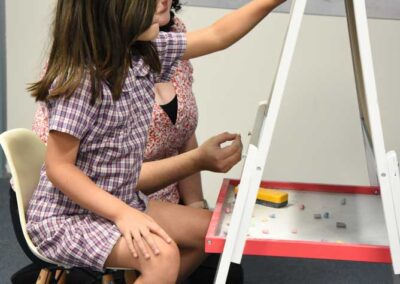As a paediatric speech pathologist, it’s likely that some of the clients you work with suck their thumbs past the age of 4 years. You may think that this is not an important issue or that it’s not something that you need to concern yourself with, but providing parents with reliable information is important for any professional working with children. Understanding the impact of long-term thumb sucking on the structure and function of the oral cavity will result in better care and improved outcomes for your clients.
Is thumb-sucking normal?
First of all, it’s important to understand that thumb- and finger-sucking in babies is completely normal, and in fact, sucking often begins in the womb. It’s a fantastic self-soothing tool that babies use to comfort and settle themselves. Thumb-sucking triggers the release of hormones such as dopamine, serotonin and endorphins, causing the infant to feel comfortable and secure.

When should a child stop sucking their thumb?
Thumb-sucking usually stops at around 3 to 4 years of age. Children develop other ways to self-regulate and calm themselves and they don’t need to rely on thumb-sucking to be able to settle. However, some children continue to suck their fingers or thumbs well into their primary, or even high school years.
Why does this matter?
It’s important to explain the potential ramifications of prolonged finger- or thumb-sucking to parents. For many children, non-nutritive sucking doesn’t cause ongoing issues, but for others it does. This is dependent on how frequently the child sucks their thumb, the angle of their thumb in their mouth and how hard they suck. These are some of the potential ramifications of prolonged thumb-sucking.
Malocclusions: One of the primary concerns associated with long-term thumb-sucking is the development of malocclusions – misalignments of the teeth and jaw. The consistent pressure exerted by the thumb against the front teeth can lead to an open bite, where the upper and lower front teeth do not meet when the mouth is closed. Another common malocclusion in thumb-suckers is an overjet where the top teeth stick outwards.
Formation of the palate: Thumb-sucking can also influence the formation of the palatal arch – the roof of the mouth. Prolonged and intense thumb-sucking can exert pressure on the palate, causing it to become narrow and high-arched. This, in turn, results in overcrowding of the teeth, as there’s not enough room for the teeth to grow into.
Tongue resting position: The resting position of the tongue is crucial for proper oral development and for developing correct speech and swallowing patterns. Persistent thumb-sucking can disrupt the natural resting position of the tongue, leading to a low tongue posture. When the tongue is not habitually resting on the palate, it is unable to exert forces that help it to grow upward and outward. Without this pressure from the tongue, the palate becomes narrow. This, in turn, further impacts the tongue resting position as the tongue may no longer be able to fit in the narrow palatal arch.
Tongue thrust: Long term thumb-sucking and a low, forward tongue resting position, is closely related to a tongue thrust. This is a swallowing pattern where the tongue moves forward and pushes against or between the teeth.
Persistent Lisp: If a child develops a forward tongue resting position and a tongue thrust, they are highly likely to have a lisp and interdental production of alveolar sounds (/t/,/d/, /n/, /l/). Without correcting these underlying issues first, you’ll be fighting an uphill, and often losing, battle to correct the lisp.
Conclusion
In conclusion, understanding the ramifications of long-term thumb-sucking is essential for speech pathologists working with children. By recognising the interconnectedness of oral habits and speech development, therapists can develop treatment plans that address both the underlying physiological issues and the resulting speech challenges. Giving parents information about this important issue provides wholistic care and helps them to make informed decisions.
Here are some useful pages to share with parents:
https://orofacialmyology.com/product/unplugging-the-thumb-2/
https://thumbsuckingclinic.com.au/parents-lounge/
Thumb Sucking – Speak, Learn and Grow (speech-learning.com.au)









